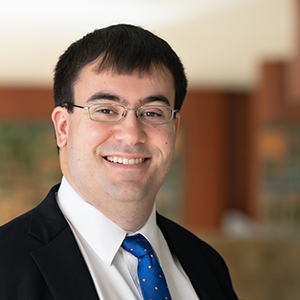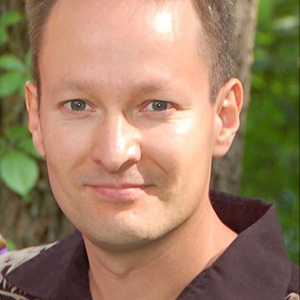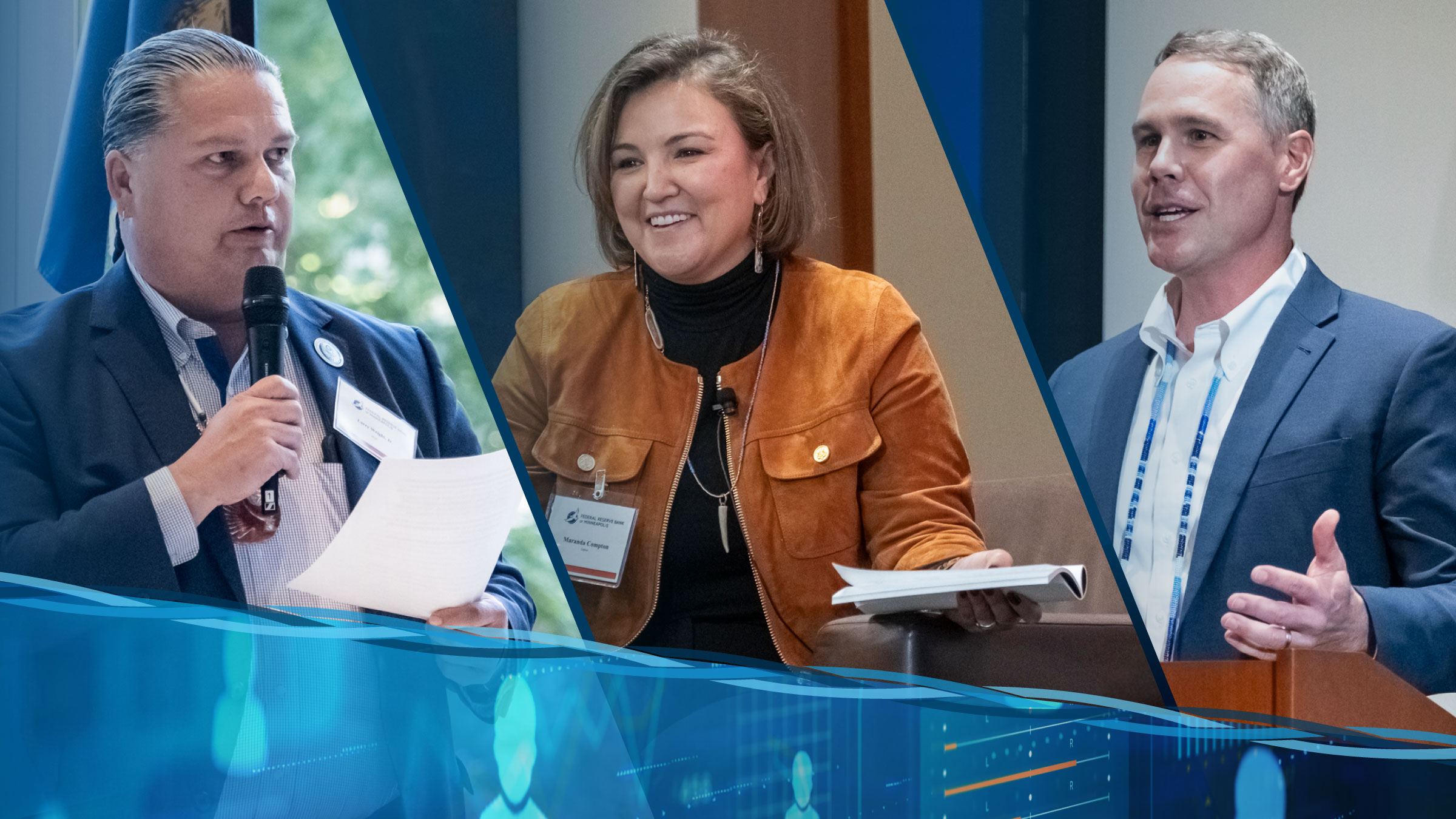The Ninth Federal Reserve District is home to many tribal nations, and the Center for Indian Country Development (CICD), based at the Federal Reserve Bank of Minneapolis, is dedicated to the prosperity of all Native nations. Several Minneapolis Fed employees reflected on their Indigenous heritage for Native American Heritage Month.
James Colombe Project manager, CICD
What is your familial heritage?
My tribal ancestry is Lakota and Nez Perce.
What Native American do you most admire and why?
Seneca Chief Red Jacket gave an incredible speech in 1805 called “Address to White Missionaries and Six Iroquois Nations” that I was able to perform in a high school competition. The speech is a fantastic piece of rhetoric that exemplifies Indigenous humanity and intellect.
What positive steps have you seen the Federal Reserve take toward supporting tribal communities?
During my time at the Bank, there has been a tremendous amount of new attention internally and externally on the Fed’s Indian Country work. I have thoroughly enjoyed watching the Fed develop and grow as an institution that recognizes Indigenous people and nations and that takes Indigenous issues seriously.
Tribal governments and businesses have been especially hard hit by the COVID-19 pandemic. The CICD is monitoring the pandemic’s effect on the economy, small business, and employment in Native communities. Read more about the CICD’s COVID-19 resources here.
Casey Lozar Vice president and director, CICD
What is your familial heritage?
I am an enrolled member of the Confederated Salish and Kootenai tribes as well as a descendant of the Ft. Peck Assiniboine and Sioux tribes—two tribal nations that make their home in Montana.
What is one thing you wish people knew about your Native culture that they may not know?
Language is a critical component of the cultural fabric for Native Americans. Across Indian Country, the number of first-generation Native language speakers has dramatically decreased over the past 50 years, but tribes are working hard to revitalize their Native languages and increase the number of speakers—often starting with Native youth. My tribe has developed modern tools, such as our Salish language app, to help pass on our language to community members regardless of where they live. As urban Indians, my children and I have relied on these technologies to begin to learn our Native language.
What Native American do you most admire and why?
My grandfather. He had a long career in the Bureau of Indian Affairs working alongside many different tribes in the West. Regardless of what reservation he worked at, he kept his ties to his family and the community on our reservation—Flathead Indian Reservation. When he retired, he became our chief tribal judge for two decades and assisted other tribal judges across Montana on mediation. His actions showed me that it is possible to work off the reservation and remain engaged in our own community, which I continue to do from Helena. Later in life, he became the patriarch of a large extended family, teaching us the importance of family, spirituality, and balance. All the while, he reminded us that laughter and humor were the secret ingredients to a fulfilling life and career.
What positive steps have you seen the Federal Reserve take toward supporting tribal communities?
The Federal Reserve is a committed partner to Indian Country. After several decades of working in Indian Country, the Minneapolis Fed memorialized our commitment to Indian Country when we launched the CICD. With Indian Country operating in a “data desert,” the CICD’s focus on research has helped to deepen understanding of critical issues and opportunities such as tribal homeownership, Native employment, industry concentration, access to capital, and education in Indian Country. The Federal Reserve listens to the tribal leaders and tribal organizations throughout the country and works to be responsive to their research and data needs, all with the intention of assisting tribes to reach their full economic potential.
The CICD supports the prosperity of Native nations through actionable research and community collaboration. The CICD’s areas of focus are land, business, and entrepreneurship; housing and homeownership; and education.
What is your familial heritage?
I am a Lakota from the Lafferty family of Cheyenne River Sioux tribe in South Dakota and a descendent of the Glenn family of the Crow nation in Montana, both on my mom’s side. I’m also Filipino and German on my dad’s side.
What is one thing you wish people knew about your Native culture that they may not know?
A Native American or anyone of a nondominant culture isn’t responsible for other people’s learning of their history or culture.
What Native American do you most admire and why?
My mother, Susan. She is what is referred to as a “lost sparrow,” which means that as a young child she was taken from her Native family and put into boarding school, then foster care, and then was adopted into a very religious and conservative non-Native family and stripped of any identity. She suffered unspeakable trauma, and yet she is the kindest, most humble, and thoughtful person I know. As a young woman, she was forced to give my oldest brother up for adoption and kept it a secret for 23 years. And yet, she made certain that my siblings and I never felt alone and that we knew we belonged to our tiyóspaye (family) of relatives who prayed us back to them, including my oldest brother.
What positive steps have you seen the Minneapolis Fed take toward supporting tribal communities?
We had a Native student research intern over the summer. At his farewell meeting, he shared his sense of awe sometimes looking at his blue acrylic FRB drink tumbler. It was a reminder and a symbol to him and his classmates of his prestigious internship. His internship will be a springboard to opportunity. Inclusivity, contribution, and connection are baked into the CICD and Community Development & Engagement teams, and it’s reflected in the collaborative work that we undertake and publish. Also, the “Racism and the Economy” series kickoff signaled the Federal Reserve’s willingness to host candid conversations about structural racism and racialized capitalism—that’s bold and admirable.
Racism forms the foundation of inequality in our society, and it threatens our economy and limits economic opportunity for people of color. The Federal Reserve Banks of Atlanta, Boston, and Minneapolis are partnering to highlight the implications of racism in the United States and identify solutions. Read more about the “Racism and the Economy” series here.
What is your familial heritage?
My grandmother on my mother’s side is full-blooded Mohican from the Stockbridge-Munsee tribe, currently near Bowler, Wis., but our ancestral homelands are in upstate New York along the Hudson River.
What is one thing you wish people knew about your Native culture that they may not know?
The story “Last of the Mohicans” leads a lot of people to believe that the Mohican nation was wiped out, but it wasn’t; we were just forced to move West.
What Native American do you most admire and why?
John Quinney, who was also Mohican, served as a delegate for the Mohican people in the early 1800s and made many trips to Washington to represent our tribe in front of Congress. He was a very eloquent speaker and was able to help settle many land disputes for our people.
What positive steps have you seen the Minneapolis Fed take toward supporting tribal communities?
I was very excited when I found out that we created the CICD. I can’t wait to see how it develops.
Since 1993, the Minneapolis Fed has worked to promote economic development in Native communities by building networks and focusing on legal infrastructure and finance for tribal nations. The CICD was established in August 2015 under former Minneapolis Fed President Narayana Kocherlakota as a commitment to serving Indian Country for the long term. Read more about Director Casey Lozar’s plans for the future.
Alyssa Augustine oversees social media and digital engagement, leads the Bank's content strategy, and manages media relations for President Neel Kashkari and other Bank leaders. An experienced TV journalist, Alyssa also contributes articles to the Bank's website and publications.









